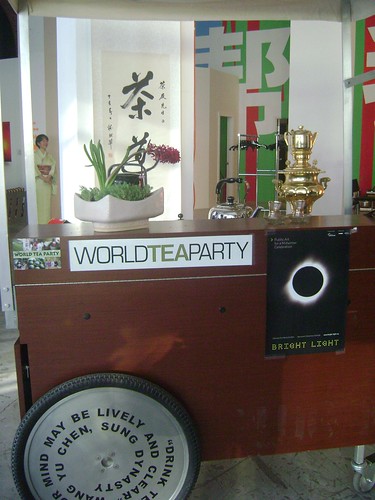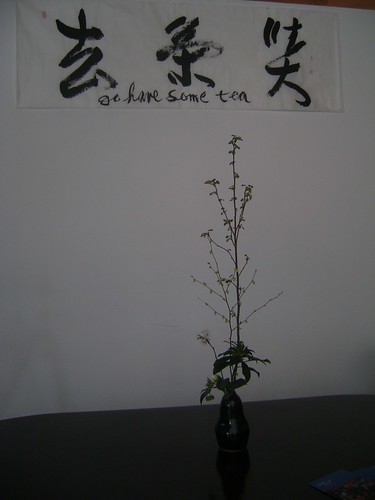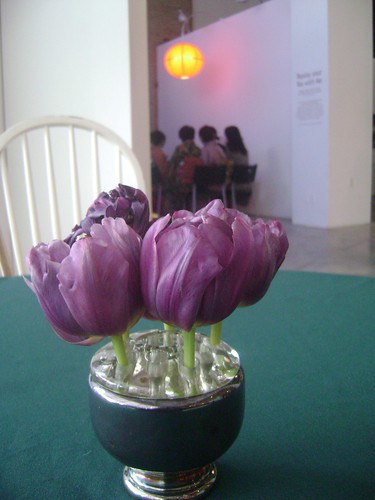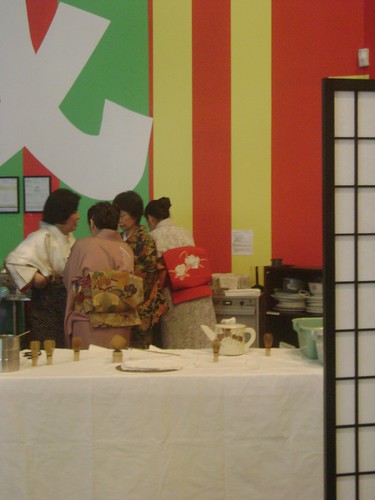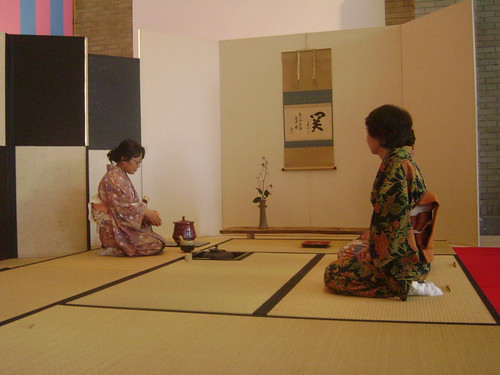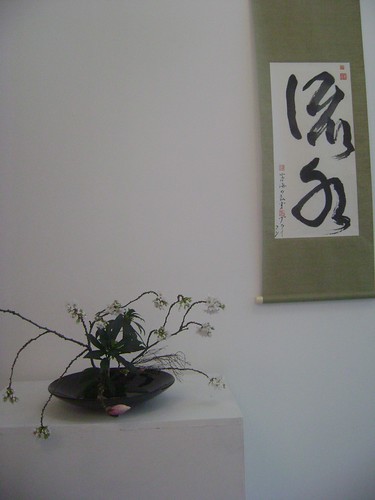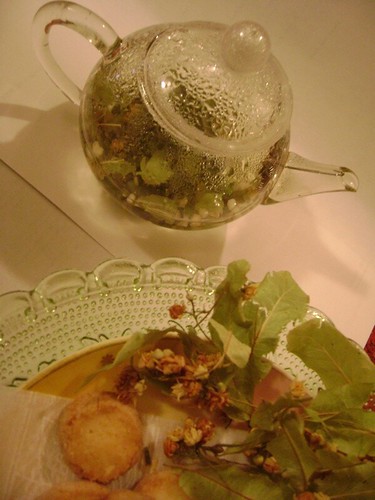 Postcard design by Dawna Ehman
Postcard design by Dawna Ehman *If you register prior to September 27th, 2007 single class discount of 20%
**That means that you get one theoretical class for free.
CLASS 1. ORIGINS OF NATURAL AROMATICS
We begin our aromatic journey with the prehistoric origins of incense and follow the evolution of aromatic plants by noting their developments throughout recorded history up to the 21st century - including an outlook on the future of aromatic plant production for use in herbalism, tea culture and perfumery.
When: Thursday October 11, 6:30 p.m. to 8:30 p.m.
How much: $25 (Space limited to 10 students)
Part 1. History of Natural Aromatics in Herbalism, Tea Culture and Perfumery – from Antiquity to Today
Part one follows the historic evolution of aromatic plant use with a focus on incense, perfume, tea and herbalism. We journey back in time to the prehistoric ritual use of incense and then on to the ancient civilizations of Egypt, Greece and the Middle East to explore the developments of perfume. We discover tea in ancient China and take a brief look at the unique usage of aromatic plants in medieval herbal practices.
In this first class we will experience two ancient uses of aromatics:
i.) Clearing Space Ritual - using Egyptian Kyphi incense (one of the most sophisticated perfumes of antiquity – a blend of 16 different aromatics plant materials that was used both as an incense, perfume and as medicine)
ii.) Jasmine Tea Sampling - experience the first aromatized tea
Part 2. The Ecology of Herbs, Tea and Perfume Production Today and for the Future
Part two of this class looks at how the nature of aromatic plant production has evolved to define its current 'ecology'. We address the central challenges and threats to these ancient art forms alongside our current use of teas, herbs, essential oils and natural raw materials. Discussion includes the implications of bio-piracy, capitalization, economics and government regulations, large scale agriculture, globalization, etc.)
Class will close with a guided meditation on our outlook to the future and our intentions for making a positive change in the ecology of aromatics.
CLASS 2. THE LIVING LANGUAGE OF PLANTS
Learn about the powerful yet subtle language of healing & beauty in aromatic plants. In this fascinating class we will discover how plants form impressions within our own psyche and we will learn to appreciate the myriad relationships they have to our emotions and memories. This class also covers safety guidelines for using natural aromatic plants and extractions and offers a unique opportunity to appreciate some of the most precious botanical aromatics available.
When: Thursday October 18 ( 6:30 p.m. to 8:30 p.m.)
How much: $25 (Space limited to 10 students)
Part 1. Energetic Properties of Plants and Aromatics
In this lesson, we dive deep into the realm of plant energies and learn to appreciate the unique correlation between the energetic nature of a plant and what it may reveal through the emotional response of both our nervous system and our memory. We will also observe important factors that influence the energetic properties of aromatic plants (including seasonal shifts, growing methods, harvesting, processing and storing methods).
We will begin our exploration of perfumery and personality and also look at how different forms of aromatic extractions of the same plant reveal varying levels of energetic concentrations and consequent physiological responses. Finally we will explore how to incorporate aromatic plants into our lives as a way to enhance our emotional well being.
Exercise: Tea ceremony as a meditative practice and an opportunity for mindfulness.
Part 2. Determining Quality and Safety
In part two of The Living Language of Plants, you will acquire basic tools, tips and guidelines for assessing raw materials and for using them appropriately and efficiently. Through exercise and demonstration you will learn how to determine quality (i.e.: how do I know if a material is natural or synthetic? how to tell if it’s fresh or stale?). We’ll also discuss ratios and proportions, how to troubleshoot (i.e.: clean your skin of sticky resins and oils, or how to avoid skin irritations) and learn how to use plant aromatics responsibly and respectfully- to ensure your pleasure and safety are not compromised.
Exercise: Assessing qualities of synthetic vs. natural aromatics through demonstration and assessment (e.g.. pure vanilla extract vs. artificial vanilla flavor; pure attar of rose vs. rose fragrance oil).
CLASS 3. UNVEILING THE MYSTERIES OF AROMATIC EXTRACTIONS
Uncover the many methods used to extract plant essences, and experience precious botanical essences from around the world. We will also explore the mysterious connection between plants and humans, and how plants can assist us to live a full, healthy life and in harmony with our environment.
When: Thursday October 25 ( 6:30 p.m. to 8:30 p.m.)
How much: $25 (space limited to 10 students)
Part 1. Plants and Human Form - The Correlating Healing Relationship
Explore the mysterious connection of 'form and function' between plants and humans, and observe how plants can assist us to live a full, healthy life in harmony with our environment. We’ll learn about he correlation between the three layers of our skin (epidermis/dermis/subcutaneous) and the three organ sections of plants (flower, leaf & stem, root), and how to transform plant matter into healing infusions, macerated oils, tinctures and salves.
Exercises: Comparison between plant structure and the human body; making an infused oil for healing and skin care purposes.
Part 2. The Building Blocks of Natural Perfumery
Uncover the many methods used to extract plant essences, and experience precious botanical essences from around the world. By the end of this lesson, we will understand the different distillation and extraction methods of aromatic plants, and learn the difference between essential oil, absolute, hydrosol, floral wax and concrete. Sampling and demonstration of the essences that result from these processes will be presented so you can truly understand the differences between the various essences and their qualities by using your senses – sight, touch and smell.
Exercises: Learn to recognize top, heart and base notes. Compare the results of five different extractions from the same plant (i.e.: neroli, orange blossom absolute, orange flower water, orange flower water absolute)
CLASS 4. THE ART OF BLENDING
Discover the artistry and science of blending pure aromatic substances when creating unique loose leaf tea blends and natural botanical perfumes. We will also discover the unique interrelatedness of tea and perfume, such as perfuming teas with flowers and using tea notes in modern perfumery. There will be opportunity to sample tea blends, perfumes, assorted plant elixirs.
When: Thursday November 1 ( 6:30 p.m. to 8:30 p.m.)
How much: $25 includes materials (space limited to 10 students).
Part 1. The Art of Blending and Tasting Teas
In this lesson you will learn about the basic principles of tea blending and the different stages of the tea-tasting experience: you will learn how to reveal the aromatic bouquet. We will also discuss and compare the various methods of processing teas (i.e.: the differences between white, green and black teas) and learn about how teas are graded. And last but not least – we’ll demonstrate with samplings the two methods of flavoring tea - aromatizing and perfuming, and learn about the difference between the two.
Exercises: Tea Tasting Techniques and Drawing up your Aromatic Palette in Tea Tasting
Part 2. The Art of Blending and Wearing Perfumes
This lesson will be dedicated to exploring both traditional and modern approaches to blending a perfume. We will discuss the “fragrance pyramid” (i.e.: top, heart and base notes), and reveal the different methods of composing perfume such as the structured “Accord” approach (i.e.: building horizontal and vertical chords), the exploratory or intuitive approach, working from briefs, and more. You will experience first-hand the development and structure of a natural perfume - on your own skin, and as we walk you through the different aspects that went into designing it, both conceptually and structurally.
Exercises: Evaluating building blocks (top, heart and base); perfume demonstration: walking through the process of perfume creation from concept to creation, and pulling apart the notes of a particular perfume on a scent stripes to analyze its structure.
CLASS 5. BASIC FORMULAS FOR HEALING, PLEASURE AND WELLNESS
Learn how to use quality aromatic botanicals (herbs, loose leaf teas, essential oils, absolutes, concretes and floral waxes) in the formulation of teas, tisanes, herbal first-aid preparations, and perfumes – both solid and liquid. This class is entirely “hands on”. All materials needed will be provided.
When: Thursday November 8 ( 6:00 p.m. to 9:00 p.m.)
How much: $75 including materials (space limited to 6 students).
Part 1. Herbs in Formulation
We begin our hands-on workshop of formulations with a brief discussion of common aromatic herbs (including therapeutic flowers, roots and leaves) that can prepared for practical daily usage. We will explore the significance of synergy when formulating herbs for potency, longevity and efficacy. We will learn to appreciate the application of herbs in several unique and creative formulations including dream pillows, healing creams and love elixirs and take a brief look at the formulating practices of some of the world's oldest herbal traditions.
Demonstration: what to include in your herbal first-aid kit
Exercise: methods of blending an herbal tea
Part 2. Perfumes in Formulation
This lesson is dedicated to your first attempt at blending your own natural perfume. From a given aromatic palette, you will select your own favorite notes to make a perfume that will bring you both pleasure and pride. Drawing on the knowledge from the previous class – about the classifications of notes, volatility rate, perfume structure and blending approaches, you will make a perfume that is simple yet elegant and with the guidance of an experienced natural perfumer, is sure to smell good and have a good and lasting power. This will by no means make you a “perfumer”, but it will give you a hands-on idea of what being a perfumer is like, and perhaps even inspire you to further deepen your studies of natural perfumery.
Exercises: Visualization and conception of perfume idea
Planning and blending a solid perfume
CLASS 6. COOKING WITH HERBS, TEAS AND PLANT OILS
"We cook and complain that it's a waste of time, when we should be pouring our love into making that food" (Paulo Coelho, "The Witch of Portobello")
Join us for a fabulous evening of aromatic cooking- using fresh herbs, freshly ground spices, loose leaf teas, and essential oils- in both savory and sweet dishes. Your will be given a collection of recipes to try at home, and receive guidelines for aromatic cooking. As an inspiration, we will be preparing a “Winter Solstice” feast (which we will enjoy together at the end of the class, of course!) including an appetizer, a main course, a dessert and beverages to accompany the meal. We hope that by the end of the class you will feel inspired to use your own aromatic culinary mixtures at home and feel encouraged to express your creativity in the kitchen, using the best quality aromatics you can source.
When: Thursday November 15 (6:00 p.m. to 9:00 p.m.)
How much: $55 including materials (space limited to 6 students).
As we’d like to surprise you, we won’t reveal the exact menu until the class itself. We hope to repeat this workshop throughout the year, and change the recipes according to seasonal and regional availablilty - all so that we can support local farming as much as possible in our cooking & best exemplify what we believe in through our culinary actions.
However, we can say that each cooking workshop, no matter the season, will give some basic guidelines and recipes for:
Preparing from scratch your own ground spice mixtures and pastes (such as curries, garam masalas, etc.).
Using fresh herbs in savory dishes, dips, condiments and pickles.
Preparing your own salad dressings and marinades using essential oils and/or fresh herbs.
Cooking and baking with tea seed oil and other nutritious oils.
Alternatives to dairy and wheat (selected recipes prepared will be vegan or dairy and/or wheat free).
Using exotic spices and/or essential oils in desserts and baked goods.
Concocting specialty teas and beverages – either chilled or warm, according to the seasons.
The workshop is divided to three sections:
Part 1. Savory Dishes and Spice Mixtures
With a focus on preparing savoury appetizers, salads and main courses.
Part 2. Sweet Dishes and Desserts
Learn surprising ways to use freshly ground spices, hydrosols and essential oils when baking pastries and exotic desserts from around the world.
Part 3. Warming and Chilled Drinks
Learn how to concoct your own teas and beverages for entertaining or for accompanying a meal. By using herbs, spices and flower waters, you will learn how to transform an ordinary drink into an unforgettable treat!
CLASS 7. BEAUTIFICATION AND BODY CARE WITH NATURAL AROMATICS
Learn the basis of 'inner wisdom-outer beauty'. We will learn to prepare beautifully fragrant and sensual body products using simple and luxurious botanical elements that are readily available and use the benefits of essential oils and other fragrant materials to add another unique dimension to your daily body care rituals. By the end of the class, you will take home with you at least one body product, plus a handbook with additional recipes that you can safely and simply create at your own home.
When: Thursday November 22 (6:00 p.m. to 9:00 p.m.)
How much: $55 including materials (space limited to 6 students).
Part 1. Body Care Preparations and Recipes
Learn the fun and magic of making your own body care products from readily available ingredients. We will guide you, step by step through a detailed process of body care preparations using the finest natural aromatics for body care.
Class notes and formulas include tea based facial steams, washes and tonic waters; hydrosols for healing and beauty; plant based shampoos; herbal infused oils & butters; perfumed sugar body scrub; aphrodisiac perfume oil.
Part 2. Simple Self-Healing Techniques
In this final hands-on workshop we learn to perform enjoyable and safe self-healing techniques that use aromatic body care products prepared in the earlier part of the class. Discover how the benefit of incorporating such techniques with aromatic elements will nourish your mind, body and soul and encourage a daily personal ritual of pleasurable body care and beautification.
Class notes and formulas include: Cold water rinse in facial care; pre-shampoo scalp massage; self massage in an oil bath; reflexology pressure points of the hands and feet; self-massage techniques for headache and reflexology; temple massage with lavender oil.
